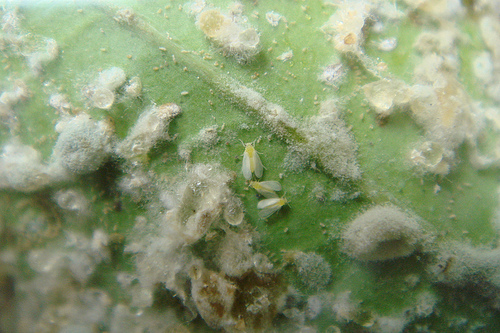
Rhodes entomology honours student, Sarah Taylor’s, woolly whitefly discovery takes her one step closer to finding a way to successfully control the woolly white fly through biological methods rather than chemical control.
Taylor is involved in a project that aims to biologically control the alien fly, undertaken by Rhodes Entomology with Citrus Research International (CRI). CRI programme manager, Sean Moore works closely with Professor Martin Hill and Taylor, in the Department of Zoology and Entomology.
The woolly whitefly, Aleurothrixus floccosus (Maskell) (Hemiptera: Aleyrodidae), has recently emerged in Stellenbosch, Cape Town, Pretoria, Port Elizabeth and Grahamstown. Thankfully it has not yet been found in commercial orchards as it poses a threat to the highly productive citrus industry of the country.
In South Africa there is currently no biological control programme on this pest but parasitoid emergence holes have been noted. Predation by generalist coccinelid beetles has also been noted on this pest and may also be contributing to the control of the species.
The chemical insecticide trials are being conducted on citrus saplings infected with woolly whitefly to determine the most suitable product for the control of the pest in back garden trees at Rhodes University. Additionally a parasitoid survey has been conducted to determine what indigenous parasitoids are present and if they could control the pest rather than using chemical means.
Taylor is excited about a discovery of natural parasitoids of a new citrus pest found on the underside of a leaf of a citrus tree in Sundays River, Eastern Cape. Taylor asked the general public to check the underside of their citrus tree leaves and if they found a woolly white substance, to please contact her.
She got several responses from Port Elizabeth, Port Alfred and Sundays River and Grahamstown and received specimens for research.
The results have confirmed that the presence of regulating parasitoids in a population in Sundays River Valley (the identity of these wasps is not yet known). This means that these parasitoids, native to South Africa, might be able to control the woolly whitefly population with minimal chemical applications.
The fly has spread to citrus plantations all over the world from its native range in Central America where it was first recorded. It is now an established pest in the United States, Southern Europe and Africa.
Eradication of woolly whitefly has been attempted in both the USA and southern Europe, most of which have been unsuccessful. The failure of eradication attempts by the use of aggressive chemical spraying is firstly because of the woolly covering that protects larvae from chemicals and secondly because chemicals often have a much greater effect on population-regulating parasitoids than on the pests themselves.
The effects of the eradication programme extends to other pests of the crop and their natural enemies; in California, USA, chemical eradication (in the form of a single dificol application) had a great effect on the parasitoids of citrus red mite, causing a massive flare-up in the red mite population.
The biological control of the woolly whitefly has been relatively successful overseas with both generalist indigenous and specific imported parasitoids aiding the control of this pest abroad. In Greece, plots containing the parasitoid Cales noaki DeSantis, an exotic aphid aphinelid, and plots which did not contain C. noaki were compared and showed significant control of the population by the parasitoid results.
